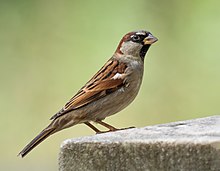
Back Huismossie Afrikaans Haussperling ALS የቤት ድንቢጥ Amharic Passer domesticus AN عصفور دوري Arabic عصفور (نوع طائر ينتمى لِفصيلة العصافير الحقيقيه ويتواجد فى معظم اجزاء العالم) ARZ ঘৰচিৰিকা Assamese Passer domesticus AST Къадако AV Ev sərçəsi Azerbaijani
| House sparrow | |
|---|---|

| |
| Male | |

| |
| Female | |
| Scientific classification | |
| Domain: | Eukaryota |
| Kingdom: | Animalia |
| Phylum: | Chordata |
| Class: | Aves |
| Order: | Passeriformes |
| Family: | Passeridae |
| Genus: | Passer |
| Species: | P. domesticus
|
| Binomial name | |
| Passer domesticus (Linnaeus, 1758)
| |

| |
| Range of P. domesticus Resident Non-breeding Extant and introduced (resident) Possibly extant and introduced (resident) Possibly extinct and introduced
| |
| Synonyms[2] | |
|
Fringilla domestica Linnaeus, 1758 | |
The house sparrow (Passer domesticus) is a bird of the sparrow family Passeridae, found in most parts of the world. It is a small bird that has a typical length of 16 cm (6.3 in) and a mass of 24–39.5 g (0.85–1.39 oz). Females and young birds are coloured pale brown and grey, and males have brighter black, white, and brown markings. One of about 25 species in the genus Passer, the house sparrow is native to most of Europe, the Mediterranean Basin, and a large part of Asia. Its intentional or accidental introductions to many regions, including parts of Australasia, Africa, and the Americas, make it the most widely distributed wild bird.
The house sparrow is strongly associated with human habitation, and can live in urban or rural settings. Though found in widely varied habitats and climates, it typically avoids extensive woodlands, grasslands, polar regions, and hot, dry deserts far away from human development. For sustenance, the house sparrow routinely feeds at home and public bird feeding stations, but naturally feeds on the seeds of grains, flowering plants and weeds. However, it is an opportunistic, omnivorous eater, and commonly catches insects, their larvae, caterpillars, invertebrates and many other natural foods.
Because of its numbers, ubiquity, and association with human settlements, the house sparrow is culturally prominent. It is extensively, and usually unsuccessfully, persecuted as an agricultural pest. It has also often been kept as a pet, as well as being a food item and a symbol of lust, sexual potency, commonness, and vulgarity. Though it is widespread and abundant, its numbers have declined in some areas.[3] The animal's conservation status is listed as least concern on the IUCN Red List.
- ^ BirdLife International (2019) [amended version of 2018 assessment]. "Passer domesticus". IUCN Red List of Threatened Species. 2019: e.T103818789A155522130. doi:10.2305/IUCN.UK.2018-2.RLTS.T103818789A155522130.en. Retrieved 16 March 2022.
- ^ Summers-Smith 1988, pp. 307–313.
- ^ "Study finds even the common House Sparrow is declining | CALS". cals.cornell.edu. 11 February 2021. Retrieved 20 October 2024.
